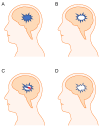Applications and Efficacy of Iron Oxide Nanoparticles in the Treatment of Brain Tumors
- PMID: 40284493
- PMCID: PMC12030199
- DOI: 10.3390/pharmaceutics17040499
Applications and Efficacy of Iron Oxide Nanoparticles in the Treatment of Brain Tumors
Abstract
Cancers of the central nervous system are particularly difficult to treat due to a variety of factors. Surgical approaches are impeded by the skull-an issue which is compounded by the severity of possible harm that can result from damage to the parenchymal tissue. As a result, chemotherapeutic agents have been the standard of care for brain tumors. While some drugs can be effective on a case-by-case basis, there remains a critical need to improve the efficacy of chemotherapeutic agents for neurological cancers. Recently, advances in iron oxide nanoparticle research have highlighted how their unique properties could be leveraged to address the shortcomings of conventional therapeutics. Iron oxide nanoparticles combine the advantages of good biocompatibility, magnetic susceptibility, and functionalization via a range of coating techniques. Thus, iron oxide nanoparticles could be used in both the imaging of brain cancers with magnetic resonance imaging, as well as acting as trafficking vehicles across the blood-brain barrier for targeted drug delivery. Moreover, their ability to support minimally invasive therapies such as magnetic hyperthermia makes them particularly appealing for neuro-oncological applications, where precision and safety are paramount. In this review, we will outline the application of iron oxide nanoparticles in various clinical settings including imaging and drug delivery paradigms. Importantly, this review presents a novel approach of combining surface engineering and internal magnetic targeting for deep-seated brain tumors, proposing the surgical implantation of internal magnets as a next-generation strategy to overcome the limitations of external magnetic fields.
Keywords: drug delivery; iron oxide nanoparticles; neurological cancer.
Conflict of interest statement
The authors declare no conflicts of interest.
Figures



References
-
- Ostrom Q.T., Cioffi G., Gittleman H., Patil N., Waite K., Kruchko C., Barnholtz-Sloan J.S. CBTRUS Statistical Report: Primary Brain and Other Central Nervous System Tumors Diagnosed in the United States in 2012–2016. Neuro Oncol. 2019;21((Suppl. S5)):v1–v100. doi: 10.1093/neuonc/noz150. - DOI - PMC - PubMed
-
- Fernandes C., Costa A., Osorio L., Lago R.C., Linhares P., Carvalho B., Caeiro C. Current Standards of Care in Glioblastoma Therapy. In: De Vleeschouwer S., editor. Glioblastoma. Codon Publications; Brisbane, Australia: 2017. - PubMed
-
- Chang C.H., Horton J., Schoenfeld D., Salazer O., Perez-Tamayo R., Kramer S., Weinstein A., Nelson J.S., Tsukada Y. Comparison of postoperative radiotherapy and combined postoperative radiotherapy and chemotherapy in the multidisciplinary management of malignant gliomas. A joint Radiation Therapy Oncology Group and Eastern Cooperative Oncology Group study. Cancer. 1983;52:997–1007. doi: 10.1002/1097-0142(19830915)52:6<997::AID-CNCR2820520612>3.0.CO;2-2. - DOI - PubMed
Publication types
LinkOut - more resources
Full Text Sources
Research Materials

